The school year is rapidly coming to an end and that means cleaning, repairing, and reviewing your IPM records. This newsletter is to help you prepare for the summer and help your IPM program grow.
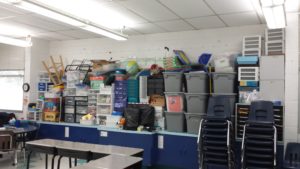
This room is ready for summer, the teacher has placed all their supplies in storage containers. The room can have it’s deep cleaning and if custodial or the teacher finds evidence of pests in August, then you know where to start.
Before school ends be sure to send out an email to your teachers and principals reminding them to take home classroom pets, food items (even the macaroni art), and other personal items you would like out of their classroom. At the same time, you might need to remind them to store those items they want to keep in the rubber storage containers, so that your custodial staff can easily move these in and out of the classroom to clean.
As your staff cleans each campus, remind them to be on the lookout for evidence of pests. As they move items away from walls and expose the room for deep cleaning, workers need to make note of cockroach droppings, shed skins, wings, and other indicators that mice or cockroaches are living undetected most of the year, and report these findings to you the IPM Coordinator.
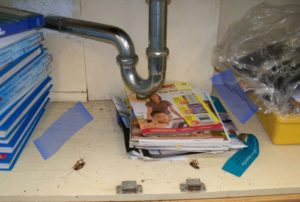
While the dead roaches in this cabinet is important. What I see is openings behind the wall where they can enter and live (focus at the end of blue lines). Everything needs to come out, cleaned, and monitor for activity. If activity is found then baiting is best for this area.
Have them look for small openings along baseboards, bookcases, ceiling tiles and especially in storage rooms. Are they sweeping up a lot of spilled items like beans, sawdust, dust bunnies, etc. that could be an indication of insect or mammal activity?
Before the food service group leaves for the summer it’s critical that they place as much of their food items like condiments into rubberized sealed containers, so that those items are not subject to contamination. At the same time, food service staff should ensure that all food processing equipment is cleaned inside and out. Too often the inside doesn’t get cleaned and this food debris can become a food source for a hidden cockroach. Monitoring devices should also be placed in areas that have floor drains, several cockroach species can use these sewer pipes as highways to find food and shelter. Remind food service that the IPM coordinator and pest control applicator will need to access the food storage rooms during summer. Too often I see this left unnoticed for six weeks because ‘no one has the key’ and the kitchen manger comes back to a cockroach or mouse problem, because no one could inspect this critical area.
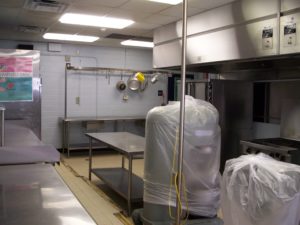
This kitchen was cleaned up for summer. What is not obvious in this image is the coldbase that is missing and broken along the ledge and walls. There was evidence of German cockroaches in the equipment, in the ceiling tiles, and other areas.
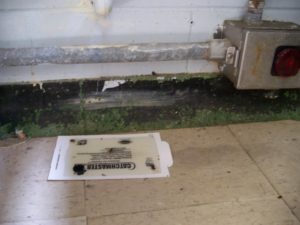
This is one of the monitors from the kitchen (left). With a pest problem like German cockroaches this requires frequent inspections to ensure control measures are working. Look closely notice the floors and wall behind.
Finally, taking time during the summer to organize your IPM paperwork can help you identify unknown pest problems. If you haven’t filed all those service tickets that your pest control contractor has dropped off, now is the time to do it. As you file these away, hopefully by campus, look to see if there is evidence of pests. What comments were made by the service technician, do you have work orders that correlate information for those service tickets? Most often as I inspect schools for their compliance with the TDA school IPM rules, it’s looking at the service tickets that I find the small mistakes.
When you are asked by the TDA inspector “what is your monitoring program” they really want to know what you the IPM coordinator and the pest management professional are doing to prevent pests in your schools.
Monitoring can lead to making a pesticide application, but this simple statement is one of the most confusing aspects of the school IPM rules. Because monitoring and pesticide application may not go hand and glove. Depending on where your school campus is located, how old the building is, how has it been managed, and how active is the custodial service at that location can all play a r ole in pest activity. We have all heard the slogan, location, location, location, except when it comes to schools it is all about the location. If you have a campus that is located on low land that is prone to a lot of moisture, you are going to have a variety of problems. Does the campus have water standing under the building or in the building (basement areas)? These areas need to be monitored to make sure that insects, vertebrates, and mammals aren’t finding a place to live as well.
ole in pest activity. We have all heard the slogan, location, location, location, except when it comes to schools it is all about the location. If you have a campus that is located on low land that is prone to a lot of moisture, you are going to have a variety of problems. Does the campus have water standing under the building or in the building (basement areas)? These areas need to be monitored to make sure that insects, vertebrates, and mammals aren’t finding a place to live as well.

Areas located on school buildings can become the perfect place for pests to thrive. Make sure these areas are maintained annually.
Age of the structure is important, from the time a school campus is built until it is no longer part of the district can play a key role in how the public and students perceive the District. If the campus looks worn down, not cared for: vegetation left unmanaged, lawns unmowed, soffits and eaves with missing pieces, anything that can be fixed needs to be fixed or the public thinks “we don’t care”. If a mouse can use ¼ inch (size of index finger) to enter a building, think what else can gain entrance. Birds can make nests in several openings, birds can lead to bird mites later in the year. How about that paper wasp nest that is small now, what will that look like in August? Monitoring is visually inspecting.

Having fresh fruit can bring in fruit flies, so it’s something to train employees on what to recognize.
As you can see monitoring is more than setting out glue boards in the kitchen. Monitoring is a 360-degree process, it’s an assessment of what is going on in that setting, at that time. If you have kitchens that serve food, but not prepare food, that requires a different level of monitoring. If your kitchens are preparing food, then food service staff need to be aware of a variety of pests and pest signs. IPM technicians, need to know where to place monitors and remember to chart them and check them monthly. In some of the large high school kitchens I have seen as much as 30 monitoring devices strategically placed so that the IPM team could keep an “eye” on different areas that had potential to have problems. One American cockroach on a glue board may not be problematic if it’s early August and you have dry sewer lines; however, that same cockroach found later in the year and it’s on a counter, then you might need to inspect even more.
When you monitor, and you have evidence of a nuisance pest, jumping spiders don’t count, then based on your management plan your pest management professional should be able to make an application. With so many baits on the market, the most common first step is identifying your pest, it’s not just an ant or roach, and then choosing an insecticide bait that works the best for that specific pest. As the IPM coordinator you need to look at the service tickets, if you contract out, to see what your company is using. When I conduct those compliance audits, this is when I notice that the first product of choice isn’t a bait, but a spray. The spray that is used typically has an active ingredient that ends in “thrin” which means it’s a yellow category product and requires a form as well.
Here are the things the TDA inspector will look for 1) what type of monitoring on you and the pest management company doing? Can you document it? 2) are you posting as required by law? 48 hours in advance of any indoor treatment? 3) does the service ticket have all the information completed that is required by TDA for any pesticide application? Things that are missing, target pest (not just an ant), applicator name and license number, and justification form; 4) not a green category product then a justification form signed by the certified applicator is on file with the IPM coordinator. This last item is the number one violation for Texas School IPM programs. This seems so simple and in some cases like a bunch of red tape, but what this document is designed for is to remind the applicator and IPM Coordinator that there are green solutions, and have you explored those options? In some cases, the product you are using is the best solution, if you can explain that on the form, TDA will be pleased.
Remember we have our fact sheet Recognizing Green Category Products to learn more about Green category products.
Still need to train your employees about IPM, then visit our Training Modules page we have training for everyone from teachers, custodians, grounds, and food service.
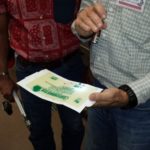

 .
.